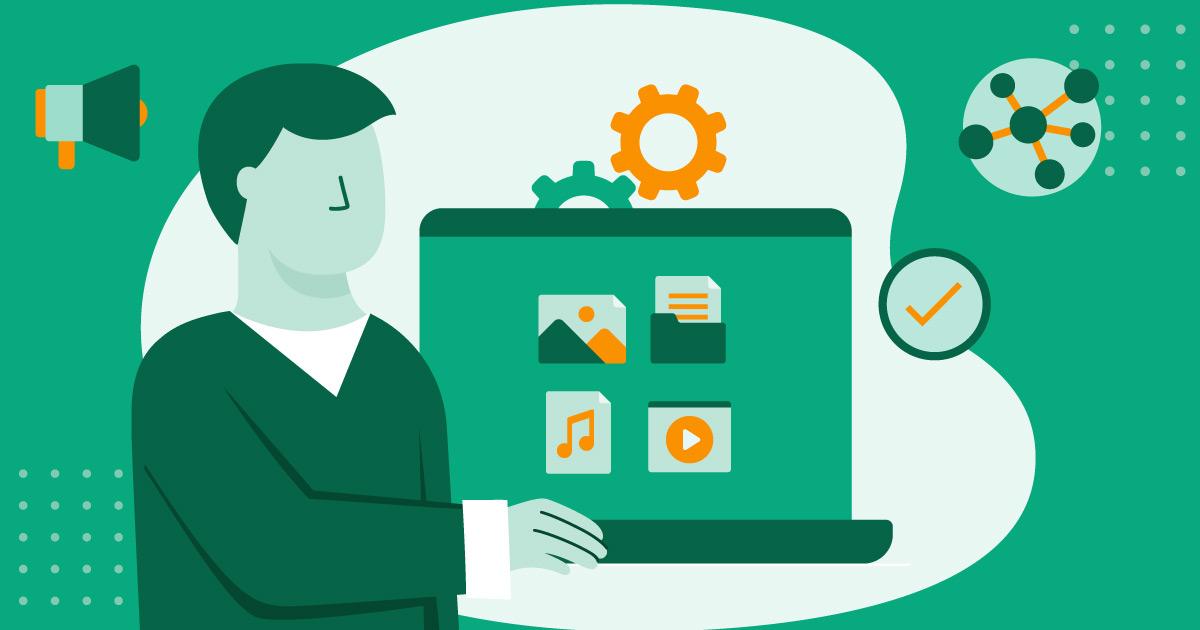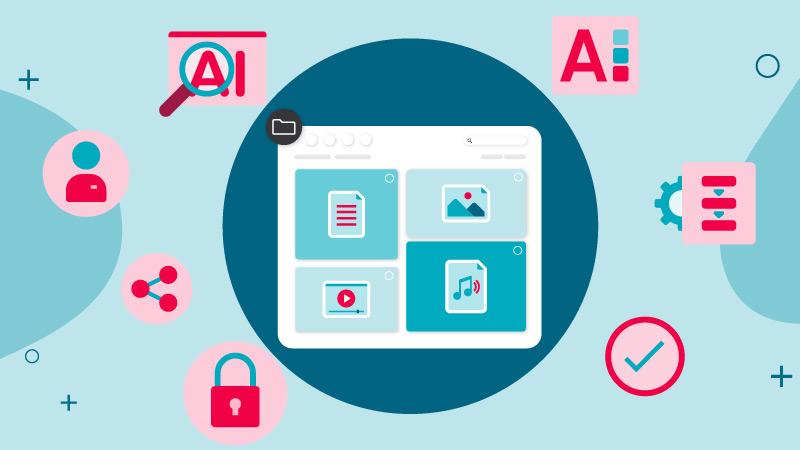What is marketing asset management?

Marketing asset management (MAM) is a system that helps marketing teams centrally store, organize, manage, and distribute their marketing assets. These assets include all forms of content and marketing collateral used in campaigns, such as images, videos, documents, logos, and presentations.
Effective MAM helps team members quickly find and use the right materials, saving time and ensuring consistency across all marketing channels.
Using MAM software, you can:
What are the benefits of marketing asset management software?
From eliminating repetitive tasks to maintaining brand consistency and scaling your AI marketing strategy, there are six key benefits to using marketing technology (MarTech) for asset management.
1. Improved efficiency
Your MAM software acts as a central repository for all your marketing content. With all content in one library, asset retrieval becomes much easier, allowing team members to quickly find and access what they need without wasting time tracking down files scattered across cloud storage.
You can also automate repetitive metadata management tasks like tagging and categorizing. Additionally, asset version control is greatly simplified, reducing manual work and speeding up workflows.
For instance, one popular motorsport racing brand uses tools from a type of MAM software called digital asset management (DAM) to automatically tag and categorize images according to metadata. Advanced facial recognition capabilities also organize content featuring the brand’s drivers and key personnel. Then, once the content is in the main DAM library, the team can review it to determine what needs to be available to partners. Powerful search functionalities keep assets quickly accessible for anyone using keywords, tags, or filters.
2. Better collaboration
Marketing asset management software makes it easier for your team to work together. Multiple team members can work on assets simultaneously, resulting in project synergy and faster approval workflows. Customizable workflows make it easier for team members to work efficiently on tasks. Plus, role-based access ensures that only authorized team members can view, edit, or distribute assets, keeping your valuable content used correctly.
Without a media asset management platform, many organizations find themselves struggling with cloud storage to share and manage files. For example, a large bicycle retailer used to rely on Google Drive to provide partners access to brand assets. They soon outgrew the system and needed a more efficient way to quickly and efficiently deliver key assets to over 300 retail partners. By moving to DAM, it became much easier for their internal team to collaborate as well as share media with retailers.
3. Brand consistency
Using marketing asset management software helps ensure your organization always looks its best by maintaining brand consistency across all materials.
Your MAM software can help you ensure that all assets comply with your brand guidelines so you can maintain a recognizable look and feel across all marketing materials.
Many MAM platforms let you store and use pre-approved brand templates. Having approved brand templates reduces the risk of team members creating and distributing off-brand materials.
4. Maximize cost savings and content value
Marketing asset management helps you save money by making the most of your marketing resources. By providing visibility into existing marketing materials, MAM prevents the creation of duplicate assets. When your team knows what existing assets are in your library, you lower production costs and don’t waste time and money creating assets you already have.
Plus, as marketing teams find and reuse content across different campaigns and channels, you’ll increase the ROI of your existing assets. Your company will get more value out of each asset without the need to constantly produce new content.
5. Regulatory compliance
MAM helps you ensure that your organization uses assets within the bounds of licensing agreements. Built-in digital rights management lets your business track usage rights and restrictions and avoid any potential legal issues and fines.
Plus, MAM can help you comply with key regulations such as:
6. Scale content management
Marketing asset management systems grow with your organization and make it easier to scale up. Using one source of truth, you can easily manage an increasing number of digital assets without compromising on accessibility.
Also, MAM platforms integrate with other marketing tools to create a cohesive marketing toolkit that supports the entire department. A cohesive toolkit makes it easier to manage campaigns and assets for everyone.
Most MAM software includes content dashboards and reporting to highlight asset performance and inform future marketing strategy.
Make sure you choose a MAM with multi-language UI capabilities to support globally dispersed teams, making it easier to maintain consistent marketing efforts across different regions.

What are the types of marketing asset management software?
From DAM platforms to project management tools, there are multiple types of MAM software you could add to your marketing stack.
1. Digital asset management platforms
Digital asset management (DAM) platforms like Canto make it easy to centrally store, organize, find, and distribute digital assets like images, videos, and documents.
Pros:
- Centralized storage: Keeps all digital assets in one place, making it easy to manage and access marketing collateral and more
- Asset organization: Automatically streamlines marketing metadata management using AI tagging
- Advanced search options: Advanced search functionality locates assets using keywords and tags, and AI facial recognition finds media featuring people
- Improved collaborative marketing: Allows multiple users to access and work on marketing assets
- Workflow management: Unifies teams and content with one platform to handle all approval workflows
- Brand management: One platform to maintain brand identity, including brand and compliance controls such as DRM, version controls, approval statuses, and expiration dates
- Publication systems: Enables content collection sharing and automates media delivery onto sites and storefronts
- Integration: DAM integrates your content library into existing systems and workflows
Cons:
- Price: May be costly to implement and maintain
- Complexity: Users may need some training to fully use all the features
2. Content management systems (CMS)
CMS platforms like WordPress and Drupal manage the creation, editing, and publishing of website and blog content.
Pros:
- Ease of use: User-friendly interfaces that allow non-technical users to create and update content
- SEO tools: Built-in tools to optimize content for search engines
- Templates: Pre-designed templates simplify the creation of consistent and professional-looking content
- Integration: Can integrate with various plugins and tools to extend functionality
- Cost: Some CMSs are free out of the box
Cons:
- Limited digital asset management: Not as robust in handling large volumes of various digital asset types when comparing DAM vs CMS systems
- Security: Can be vulnerable to security threats if not properly managed and updated
- Customization: Customizing beyond basic templates can require technical expertise
- Performance: Can slow down due to heavy traffic or extensive content without proper optimization
3. Creative tools
Creative tools like Adobe’s Creative Cloud and Canva help users design and create visual content for marketing campaigns.
Pros:
- Design flexibility: Provides a broad selection of design tools and customization options
- Templates: Provides pre-designed templates to streamline the content creation process
- Collaboration: Some file formats support real-time collaboration, allowing multiple users to work on a project simultaneously
- Ease of use: Canva, in particular, is user-friendly and accessible to non-designers
Cons:
- Cost: Adobe products can be expensive, especially for small teams or individual users
- Learning curve: Adobe tools have a steeper learning curve compared to simpler platforms like Canva
- Limited digital asset management: Primarily focused on creation rather than asset storage and management
- Integration: May require additional tools or platforms to integrate with a broader marketing asset management system
4. Project management tools
Project management tools like Adobe Workfront, Wrike, and monday.com help teams plan, manage, and track marketing projects and tasks.
Pros:
- Task organization: Helps organize and prioritize tasks for better project management
- Collaboration: Facilitates team communication and collaboration with features like messaging, file sharing, and comments
- Tracking: Provides tools for tracking progress, deadlines, and project milestones
- Integration: Often integrates with other tools and platforms to streamline workflows
Cons:
- Complexity: Sometimes there’s an overkill on features for small teams or simple projects
- Cost: Advanced features often come with a higher price tag
- Learning curve: May require training for team members to use effectively
- Limited digital asset management: Focuses more on project tracking than managing digital assets

How to choose the best marketing asset management system
Before you commit to a marketing asset management system, ensure your chosen platform checks these boxes:
- Features: Look for AI-powered search, AI facial recognition, AI tagging, version controls, content controls, and workflows
- Scalable: Check that the digital marketing asset library can scale as your organization and marketing strategy evolve
- Integrations: Make sure your MAM integrates with the marketing tools and applications your department already uses or plans to purchase in the future
- Compliance and security: Confirm the MAM platform offers user controls, encryption, secure storage, and DRM to protect your assets
- Customer support: Visit review sites to verify vendors are known for stellar implementation, training, and customer support
Why choose digital asset management for marketing asset management
Organizations that need to scale marketing asset management should choose a DAM platform. With digital asset management software, you get a single platform to manage all marketing content while maintaining brand consistency across channels.
DAM software like Canto includes everything marketing teams need, including AI-powered search, AI tagging, facial recognition, brand management, version controls, DRM, content workflows, and more.
The Beginner’s Guide to Digital Asset Management
Download the guide for free
Marketing asset management frequently asked questions
What are the key features of a marketing asset management system?
A marketing asset management system should include the following key features:
These key MAM features will help you efficiently organize, find, and manage your marketing assets.
Is DAM the best marketing asset management software?
DAM (digital asset management) software is a top choice for managing digital assets. DAM software offers robust features for organizing, storing, and sharing assets like images, videos, and documents. With advanced search capabilities, brand management, DRM, version controls, collaboration tools, and sharing features, DAM software helps teams work more efficiently and maintain brand consistency.
How does marketing asset management address common challenges for brand consistency?
Marketing asset management helps maintain brand consistency with:
- Centralized storage: Keeps all approved assets in one place for easy asset organization and access
- Enforced brand style guides: Ensures all assets meet brand standards
- Template management: Provides pre-approved brand templates to create on-brand content
- Version controls: Tracks changes to ensure only the latest, approved versions are used
These features help teams produce consistent, high-quality marketing materials across all channels.